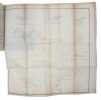"BUCH, LEOPOLD von. (+) POISSON, (SIMÉON-DENIS).
Lettre de M. Léopold de Buch à M. A. de Humboldt, renfermant de Tableau géologique de la Partie Mériodinale du Tyrol. (+) Sur la Chaleur des Gaz et des vapeurs. - [THE MATHEMATICAL ANALYSIS OF HEAT - POISSON'S ISENTROPE.]
Paris, Crochard, 1823. 8vo. In a bit later half cloth with gilt lettering to spine. In: ""Annales de Chimie et de Physique, Par MM. Gay-Lussac et Arago."", tome 23. Entire volume offered. No institutional stamps. (Buch's paper: pp. 276-304). (Poisson's paper:) pp. 337-352. (The entire issue:) 448 pp. + 2 plates.
Reference : 60068
First printing of this important geological survey and description of the Alphs with the first geological mapping of the area.""His (von Buch's) explorations in the southern Alps had suggested to Buch that the towering heigh of the Dolomites might be the result of upheaval, for which he thought the active agent in porphyry, including monozite. he concluded that the magnesia in which this rock is rich would also have been active in transforming the original limestone into dolomite. Buch thus came to vizualize great subterranean activities...""(DSB II, p. 555). _____________________ First appearance of Poisson's important paper on the mathematical treatment of ""specific heats"".""In ""Sur la chaleur des gaz et des vapeurs,"" published in August 1823 in Annales de chimie et de physique, Poisson developed ideas published four months before by Laplace in Book XII of Mécanique céleste. Poisson introduced all the precautions needed to render the confused notion of quantity of heat susceptible to mathematical analysis. He called quantity of heat the magnitude that characterizes the transition of a given mass of gas from an arbitrary initial state of temperature and pressure to another state. This definition makes more abstract the quantitative aspect that naturally follows from the concept of heat as a caloric fluid. Poisson could thus deal comfortably with this magnitude, since for him it is simply a function q of p, p, and ø (pressure, density, and temperature). The equation of state p= ap(1+aø) was already classic, and the growing acceptance of the notions of specific heats, at constant pressure and constant volume, allowed him to write the simple partial differential equation of which should be the integral. He also showed that independently of any additional hypothesis, and whatever the arbitray function used in the integration, the adiabatic transformations (the term did not yet exist) correspond to the formulas p · py = constant and (?+266.67)·p1y= constant, y being the ratio of the specific heats, assumed constant.""(DSB).
Bookseller's contact details
Herman H. J. Lynge & Son
William Schneider
Silkegade 11
1113 Copenhagen
Denmark
+45 33 155 335
Payment mode
Sale conditions
All items may be returned for a full refund for any reason within 14 days of receipt.
 Write to the booksellers
Write to the booksellers







